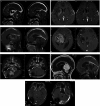A single-center experience of central nervous system tumors in children under three years old
- PMID: 39744213
- PMCID: PMC11688179
- DOI: 10.3389/fped.2024.1441016
A single-center experience of central nervous system tumors in children under three years old
Abstract
Purpose: This study aims to summarize the characteristics of children under three years old (≤3 years) with central nervous system (CNS) tumors and to investigate the factors that influence their overall survival (OS) time.
Methods: We treated 171 pediatric patients (≤3 years) with CNS tumors at Yuquan Hospital of Tsinghua University from January 2016 to June 2023. Of these, 162 cases were successfully followed up. Kaplan-Meier survival analysis and Cox regression were utilized to evaluate factors potentially influencing OS of malignancies.
Results: There was a male predominance among the patients. The three most common tumors were embryonal tumors, gliomas, and craniopharyngiomas. Gross total resection (GTR) was achieved in select cases. Patients with high-grade malignancies were advised to undergo chemotherapy and/or radiotherapy after surgery. Optic gliomas and diffuse midline gliomas were partially resected and treated with adjuvant treatments. The median survival time of low-grade malignant tumors was 41.5 months, while that of high-grade malignant tumors was 15 months. Kaplan-Meier survival analysis identified the factors potentially influencing OS of malignancies: extent of resection, CNS WHO grade, grade of malignancies, and Ki-67 labeling index (Ki-67 LI). Subsequent multivariate analysis highlighted the interactive factor (extent of resection × CNS WHO grade) along with Ki-67 LI, as the most significant variables. Factors such as sex, age, tumor location, and onset-to-treatment time appeared not to affect OS.
Conclusions: GTR remains the cornerstone of treatment for children (≤3 years) with CNS tumors, except for optic glioma, diffuse midline glioma, and germinoma. The interactive factor (extent of resection × CNS WHO grade) and Ki-67 LI are the most significant factors affecting OS. The implementation of preoperative neoadjuvant chemotherapy and early postoperative chemotherapy may enhance prognosis.
Keywords: central nervous system; chemotherapy; child; neurosurgery; pediatrics; tumor.
© 2024 Wang, Wang, Huang, Zhang and Zhang.
Conflict of interest statement
The authors declare that the research was conducted in the absence of any commercial or financial relationships that could be construed as a potential conflict of interest.
Figures



Similar articles
-
High-grade gliomas in children and adolescents: is there a role for reoperation?J Neurosurg Pediatr. 2020 Dec 11;27(2):160-169. doi: 10.3171/2020.7.PEDS20389. Print 2021 Feb 1. J Neurosurg Pediatr. 2020. PMID: 33307529
-
[Different treatment regimens for primary central nervous system lymphoma:based on SEER database].Zhonghua Wai Ke Za Zhi. 2021 Jan 1;59(1):52-58. doi: 10.3760/cma.j.cn112139-20200831-00673. Zhonghua Wai Ke Za Zhi. 2021. PMID: 33412634 Chinese.
-
Clinical features and outcomes of pediatric intracranial gliomas: results from single center's 226 cases and corroborated with SEER database.Childs Nerv Syst. 2023 Mar;39(3):593-601. doi: 10.1007/s00381-023-05841-3. Epub 2023 Jan 20. Childs Nerv Syst. 2023. PMID: 36662273
-
Extent of Tumor Resection and Survival in Pediatric Patients With High-Grade Gliomas: A Systematic Review and Meta-analysis.JAMA Netw Open. 2022 Aug 1;5(8):e2226551. doi: 10.1001/jamanetworkopen.2022.26551. JAMA Netw Open. 2022. PMID: 35972743 Free PMC article.
-
Supratentorial hemispheric ependymomas: an analysis of 109 adults for survival and prognostic factors.J Neurosurg. 2016 Aug;125(2):410-8. doi: 10.3171/2015.7.JNS151187. Epub 2016 Jan 8. J Neurosurg. 2016. PMID: 26745489 Review.
References
-
- Meng X, Ma J, Jiang F, Zhao Y, Jin H. Brain tumors in children under 3 years old:a retrospective study on clinical features. Chin J Pediatr Surg. (2012) 33(1):5–8. 10.3760/cma.j.issn.0253-3006.2012.01.002 - DOI
LinkOut - more resources
Full Text Sources

